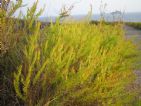
Plants Flora
Comparisson reports are under license of:

Lo que dice el Arxiduc:
“Despite the exceptionally fertile land covering the highest parts of the main island, the Columbretes have neither trees nor bushes.
It seems that this was not always the case. As Captain Smith explains, the two main promontories ‘are covered with an exuberance of dwarf olives, geraniums, prickly pears, myrtles and brushwood’.
The prickly pears—which used to be so abundant that, on the hill facing El Mascarat, you had to walk hunched over underneath them—were all destroyed, except for a few located on the high parts of Columbrete Grande and La Foradada.”
Urios, G., Nachtwey, J., Translation, Columbretes, 1895, Castellón City Council, 1990.
Datos proyecto Nixe III:
Today, unlike that commented by the Archduke, the island flora has been recovered, resembling how it may have looked before the lighthouse was built in the 19th century as described by Captain Smyth in his day.
As regards the opuntia (also known as nopales or paddle cactus), only those in the exact area described by the Archduke have been maintained.
The Nature Reserve team also adds the following points (in quotes):
“Worth noting is the presence of two species which are today endemic on Columbretes Islands: Lobularia maritima columbretensis (sweet alyssum) and Medicago citrina (alfalfa arborea).”
The experts also indicated that when the lobularia maritima bloom, they cover the islands in white. Fishermen tend to say that “it’s snowed on the island” or that the “island smells” due to the pleasant fragrance the plants give off.
 “Medicago citrina is one of the largest and woodiest shrubs found on the archipelago. In 1894 Salvator (the Archduke) indicated that there were only a few on the islands. Today, the plant is found throughout Illa Grossa which was repopulated with plants from Ferrera and Foradada.”
“Medicago citrina is one of the largest and woodiest shrubs found on the archipelago. In 1894 Salvator (the Archduke) indicated that there were only a few on the islands. Today, the plant is found throughout Illa Grossa which was repopulated with plants from Ferrera and Foradada.”
We were able to admire some just in front of the barracks.

For those interested in exploring this topic further, we recommend the magnificent comparative document prepared by the Nature Reserve staff:
“COLUMBRETES 2010. Una revisión de la situación actual de la fauna y flora citada por Salvator en 1894”.
Related files:


















